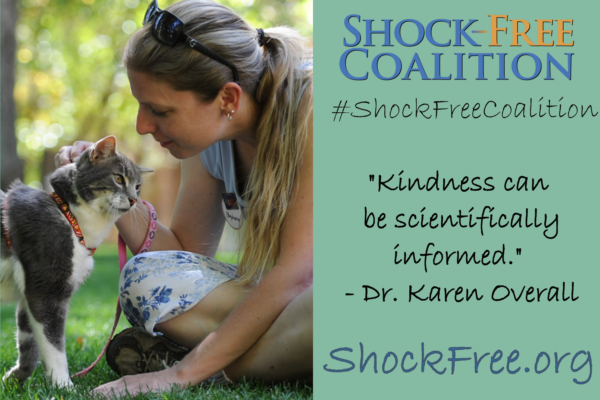Pet Guardians
Ask Your Dog Questions – Overshadowing 2
By Yvette Van Veen How to ask your dog questions…overshadowing part two. My last blog introduced the concept of overshadowing by offering a simple example to illustrate the point. For an explanation of the concept, you can read that blog here. But that basic understanding doesn’t go far enough in my opinion. Many unusual variations exist and can interfere with training. To recap, animals are more likely to attach meaning to information that is more important and noticeable – the more “salient.” Abstract variations can be hard to spot. It’s… Continued
Multinational Canine Behaviour Modification
Over the last two years or so, my behaviour practice has welcomed more and more dogs from overseas. Sometimes these are canines with profound behavioural difficulties. I have always assisted several imported dogs per year but there seems to have been an explosion of dogs from a variety of countries, thanks to the efforts of many local and larger International welfare charities rescuing such animals from dire conditions. So this year alone, I have assisted dogs from USA, Russia, various countries in Africa, India, Romania and many European countries. The… Continued
Pet Guardians Need Help Finding Professionals
As a professional dog trainer taking behavioral cases I see how confusing it can be for pet owners to know what sort of help they need and where to find it. Lack of regulation and transparency in the industry can lead pet guardians into pitfalls. This happened to a client whose dog was fearful of other dogs during leash walks. He would bark and lunge, but then retreat. The owner sought help from a trainer who took her dog into his care for several days. The trainer called her a… Continued
Fear Free™ Vet Visits: A Feline Behavior and Training Specialist’s Journey
By Victoria Blais Desperately visiting a veterinarian I had never seen before, I had a sick feeling in my stomach when I was encouraged to put on protective leather gloves to hold my highly anxious cat, Haddie. My normally sweet, affectionate girl, flattened her ears, pupils dilated, as she leaned away from the doctor. Reading her cat body language, I knew we should stop, but I reasoned, “This vet specializing in felines knows what is best.” As the vet approached Haddie, whose tail was thrashing, a loud guttural, fearful sound… Continued
Learning a New Way to Communicate
By Debbie Bauer Sometimes we know in advance if our dog will lose sight and/or hearing. I have a senior dog now who is mostly deaf from age. So far his sight seems OK, but I know it too may begin to fade. There are some things we can do to help ease this transition for our dogs. One is to teach hand signals to our dogs for basic every day behaviors (sit, lie down, wait at the door, come) and for some of the fun tricks they know (fetch,… Continued
Leaving Dogs in Cars Can Kill Them
Like many dog owners, I enjoy taking Buddha and Gandhi in my car when I run chores. They enjoy riding with me and have learned to recognize familiar locations such as the town dump, the bank, the vet clinic and even the local car wash. When I look around during those trips, I see others with dogs in their vehicles, too. Cooler fall, winter and spring months make this practice fun and relatively safe, but summer months bring the risk of heat exhaustion and hyperthermia in dogs. People can sweat… Continued
How Big Should a Cat’s Litter Box Be?
By Jennifer Mauger I was recently in a home where the resident cat was eliminating outside the litter box on a regular basis. He was a large Maine Coon mix weighing over 20 pounds. When I went to look at the litter boxes, they were well maintained, clean, and in quiet areas of the home. There were more than enough boxes for both of the cats too. The first thing I actually noticed was the size of the litter boxes. They were average size commercial litter boxes. When I asked… Continued

“Did You Know Your Dog Barks All Day?”
By Julie Naismith “Did you know that your dog barks all day?” my neighbour asked me one day. The simple answer was: no, I didn’t. It was this conversation that led me on the path to discovering my dog-ownership bombshell: that my dog Percy had separation anxiety. I can vividly recall how I felt that day my neighbour first said this to me. I had no idea Percy barked constantly when I was out. How could I have known? I’d had my other dog for a year with no complaints.… Continued
The Unintended Consequences of Shock
(Confidentiality Notice: Names in this blog have been changed to protect privacy, but the facts remain unchanged. Photographs have been used with written consent.) Betsy is a kind person who contacted a shelter in June of 2016 to help find a nice family dog to share her life with through adoption. She learned of Zelda, a female one year old mixed breed. Zelda’s online biography suggested she was “fine” with other dogs and was “friendly” with people, but jumped on them “to say hello.” Little was known about Zelda except… Continued
Clicker Training for Cats (6/6)
By Paula Garber and Francine Miller Inter-Cat Aggression Living with cats who do not get along is stressful for everyone. Sometimes the cats need to be completely separated and then formally re-introduced. In many cases, the best outcome we can hope for is for the cats to coexist peacefully to a point where they tolerate each other, even if they do not actively “like” each other. To facilitate peaceful coexistence, the environment must be arranged so that the cats can easily avoid each other and do not have to compete… Continued

You know you own a separation anxiety dog when…
By Julie Naismith Life with a separation anxiety dog differs from the ideal of dog ownership many of us have. “Lassie Come Home” it isn’t. Here are 5 ways this debilitating condition will affect your life as a dog owner, plus a few tips on how to handle the changes without losing your sanity. #1 You learn to plan way ahead for everything Once you’ve worked out your dog has separation anxiety and is in a panic whenever you go out, it gets tough to leave him. When you know the… Continued
Onset of Noise Sensitivity Might Indicate Pain in Dogs
Older dogs who develop noise sensitivity might be in pain. Other behavior changes, like a normally friendly dog showing aggression to children or dogs, have long been regarded as potential indicators of pain. But a study published in February might be the first to make the connection between the onset of noise sensitivity and pain. The researchers looked at two groups of dogs. The group they termed “clinical” had developed noise sensitivity and had diagnosed painful musculoskeletal problems. A “control” group had noise sensitivity but no known painful conditions. One… Continued
Mama Dogs Don’t Use Treats…..
By Yvette Van Veen Many people seem enamoured with the idea that we should emulate what dogs do in the wild. “Mama dogs don’t give treats in the wild,” is one of the more common expressions. This one carries quite a punch. People have a natural affinity for natural. Expressions, analogies, metaphors and idioms can serve various purposes. They can help explain, illustrate and educate. At their best, they simplify a complex topic. They are also used to influence and to persuade. The “mama dog” line usually falls into the… Continued
Retractable Leashes Are Risky
Judging by the number of people I see walking dogs with retractable leash devices on their dogs it appears the product is popular. They are also unsafe. As Dr. Karen Becker describes them “A retractable leash is not so much a leash as it is a length of thin cord wound around a spring-loaded device housed inside a plastic handle” in her article “10 Reasons Not to Use a Retractable Leash.” The length of the retractable cord varies from 15-30 feet, and may be locked in place. Pet stewards have… Continued

The Pet Professional Guild Position Statement on the Use of Shock in Animal Training
It is Pet Professional Guild’s (PPG) view that electric shock in the guise of training constitutes a form of abuse towards pets, and, given that there are highly effective, positive training alternatives, should no longer be a part of the current pet industry culture of accepted practices, tools or philosophies. In this position statement, PPG will combine decades of research with the opinions of certified animal behaviorists, and highlight the question of ethics to explain why using electric shock in the name of training and care is both ineffective and… Continued
Encouraging Play and Activity with Newly Blind Dogs
By Debbie Bauer When a dog loses his or her sense of sight, their whole world changes. There are many things that dogs can do without their sight, but dogs that started out sighted and are now blind are often confused and maybe even fearful when they can no longer see. They can’t interact with their world the way they used to. Most likely, they knew landmarks around the house and yard by sight, they knew family members by their mannerisms and how they moved, they could see the steps were… Continued
Clicker Training for Cats (5/6)
By Paula Garber and Francine Miller Introducing Cats to Each Other In a nutshell, cats should be gradually introduced to each other one sense at a time: first by scent, then by sight, and then physically. Throughout the process, positive associations are built up with the scent, sight, and physical presence of the other cat using food, play, brushing, low-key play—anything the cats enjoy. When introducing cats, you can use clicker training to help boost positive associations between them and keep them focused on you instead of each other. During… Continued

A Plug for Play
By Julie Naismith Just like humans, dogs need play time too. And one of the many beautiful things having dogs has taught me is that you’re never too old to play. You might be asking: “But, where does play fit into separation anxiety training?” I am all about fixing separation anxiety dogs, I am also passionate about encouraging them to play too. Working with an anxious dog is about more than tackling the causes of anxiety. The richer a dog’s life, the more productive anxiety training becomes. Enrichment doesn’t fix separation… Continued
Does a Deaf (and Blind) Dog Need a Hearing Dog Buddy?
By Debbie Bauer Many people think that a deaf (or blind/deaf) dog needs to have a hearing dog to follow around. This is usually not necessary. Although, if you do have a hearing dog, your deaf dog will watch him closely for cues to things that are important to him – mealtimes, going for a walk, etc. A deaf dog (or even a blind/deaf dog) will notice when the other dogs around him are getting excited, heading towards the door for a walk, or the kitchen for a treat. In fact, sometimes it… Continued

The Science of Force-Free Learning: How Our Pets Learn!
Introduction Here at the Pet Professional Guild (PPG), we like to focus on building relationships with our pets by using positive reinforcement to train new skills, and to build new behaviors as replacements for problematic ones. Because the emotional brain inhibits the rational brain (and vice versa), nobody, and that includes our pets, can learn something constructive and pleasant when in a fearful or anxious state. Positive reinforcement means giving an animal access to something he desires (e.g. food or a toy), which makes it more likely he will repeat the behavior that… Continued
Clicker Training for Cats (4/6)
By Paula Garber and Francine Miller Clicker Training for Behavioral Problems: Clawing Furniture/Destructive Furniture Scratching Destructive furniture scratching is a commonly reported problem in cats, and one of the many unwanted behaviors that clicker training can help. Without going into all the reasons cats scratch (for more details on scratching, see Scratch Here, Not There, BARKS from the Guild, July 2016, pp. 25-26), it is suffice to say that cats have to scratch. It is a natural behavior that serves many purposes. Having said that, cats can certainly be taught… Continued
Quality of Life for Blind/Deaf Dogs
By Debbie Bauer I receive a lot of great ideas for new blog posts – Thank you so much for those. I’m always looking for ideas to write about that will be useful to each of you as readers. One idea that truly intrigued me was to discuss what quality of life a blind and deaf dog can have. I think it caught my interest because I had never thought about my dogs not having a good quality of life. I began to think about how we measure quality of… Continued
Why Every Cat Needs a Place to Hide
By Dr. Lynn Bahr Has your cat ever gone MIA in your own home? I lost an entire litter of kittens once in a small 1 bedroom apartment. All five furballs disappeared while I was out running errands. Imagine my panic and the frantic search that ensued to find them. Where could they have gone? I pulled out drawers, furniture, and the refrigerator to no avail. Fearing I would find them by smell weeks later, I sat on the couch to have a good cry. That was when I heard… Continued
An Open Letter to Veterinarians on Referrals to Training and Behavior Professionals: Recommended Best Practices
Dear Veterinarian, There are numerous professional organizations that offer membership and credentials in the field of animal training and behavior. Few, however, hold their members to a strict code of conduct which involves the application of their trade through scientific protocols and the objective to cause no harm. Unfortunately, the pet training industry is entirely unregulated, meaning that anyone can say they are a trainer or behavior consultant. As a result, those who call themselves dog trainers, or even “dog whisperers,” may still be utilizing punitive methods, such as disc… Continued
« Previous 1 … 9 10 11 12 13 … 19 Next »

